- Lake Alaotra and its surrounding marshes are Madagascar’s largest wetland, a Ramsar Site that is home to globally significant biodiversity.
- Despite layers of legal protection and conservation programming, around 850 hectares (2,100 acres) of marsh disappear each year to make way for rice cultivation, much of it perpetrated by businesses.
- Local people are keenly feeling the lake’s decline, though, and a commitment to protecting it, along with some success stories, persist in pockets around its shores.
- The government is implementing a zero-tolerance campaign against illegal environmental destruction, but it remains to be seen whether this can reduce the lawlessness and impunity enough to safeguard the lake.
LAKE ALAOTRA, Madagascar — Madagascar’s environment minister, Baomiavotse Vahinala Raharinirina, celebrated World Wetlands Day last month by planting native reeds and sedges along the shore of sprawling Lake Alaotra in the country’s central highlands. The plants’ tufted tops waved high above the heads of students, officials and local residents as they carried them across the marsh and joined the minister in settling them, one by one, into the mucky ground.
The planting on Feb. 2, which covered 4 hectares (10 acres), was an attempt to revitalize a tiny portion of the lake’s marshland that people call the “reed forest” in Malagasy. Rice agriculture, overfishing, introduced species and siltation due to upland deforestation have all contributed to the striking decline of a wetland the minister described in a Facebook post the next day as being among the largest and most ecologically important not just in Madagascar, but in all of Africa.
“Unfortunately, this marsh is now completely destroyed and Lake Alaotra is drying up,” she wrote. “Many species of Alaotra are endangered.”
Despite layers of legal protection and conservation programming, sources say much of the destruction is being perpetuated by businesses involved in rice growing and fishing and by widespread defiance of protective laws. Local people are keenly feeling the lake’s decline, though, and a commitment to protecting it, along with some success stories, persist in pockets around its shores.
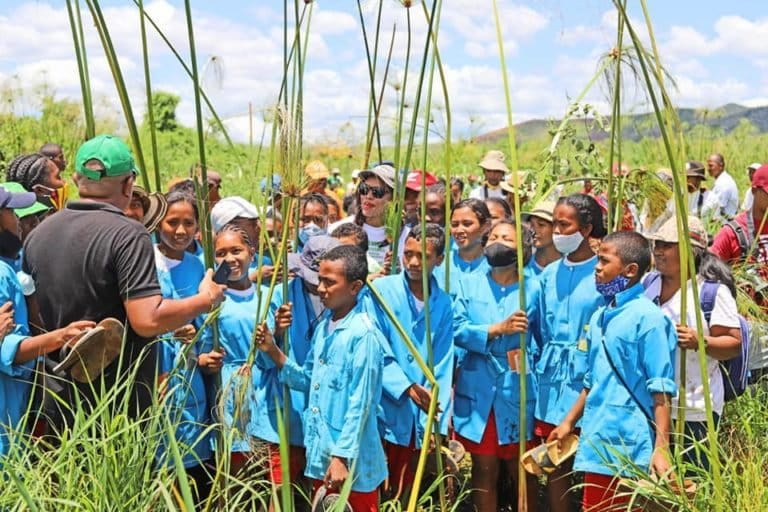
A natural jewel
With 20,000 hectares (49,000 acres) of open water surrounded by an equal area of marsh, Lake Alaotra is a natural jewel. It is home to globally significant biodiversity, including several endemic species of fish and birds and unusual mammals, such as the mongoose-like carnivore Durrell’s vontsira (Salanoia durrelli), which scientists only described in 2010, and the critically endangered bandro or Alaotra gentle lemur (Hapalemur alaotrensis).
With some 120,000 hectares (300,000 acres) of rice fields surrounding the lake, the vast Alaotra wetland is Madagascar’s main rice bowl, yielding an average of 360,000 tons of rice annually, or around 10% of the nation’s annual yield.
The lake was also once the country’s biggest inland fish supplier. But annual catches have declined precipitously, from around 2,400 tons in 2000 to barely 330 tons in 2020, according to the regional fishing department. Locals feel the loss acutely.
“I was 10 years old in 1973. We just spent a half-hour to harvest about 100 kilos [220 pounds] of quality fishes at the time,” said Randriamatsarasoa, a fisher and head of the fishers’ community association in Vohitsivalana, a village in the commune of Imerimandroso on the lake’s northeastern shore. “Nowadays, we struggle to bring home 5 to 12 kilos [11-26 pounds] after working hard from the morning to the evening.”
Such a significant shift in resource availability has resulted in fierce competition among residents that only exacerbates the ecosystem’s decline.
“These marshes represent the remaining history of the Alaotra region,” said Honoré Randriangalisa, the mayor of Imerimandroso and a deputy president of Alaotra Rano Soa, a regional body that facilitates communities’ management of the lake and marshes. “Their existence will be only a legend for the next generations if we are unable to put a stop to their destruction right now.”
Due to its importance for biodiversity and Madagascar’s agro-economy, Alaotra’s 722,500-hectare (1.78-million-acre) watershed was inscribed as a Ramsar Site under the Convention on Wetlands of International Importance in 2003. The Madagascar government designated a temporary new protected area there in 2007 and granted 46,000 hectares (114,000 acres) permanent protection in 2015.
The transformation of marshland into new rice fields is the main threat to the marshes and the lake’s health. In recent years, rice farmers have been planting vary jeby, or flood recession rice, pushing into flood-prone areas that are now often farmable during the dry season, which has become elongated by climate change. They may farm a plot for a few years then leave it fallow when conditions aren’t ideal.
“The rising trend in the reliance on the flood recession rice is a very big issue,” said Miora Ratsimanohatra, chief of the agricultural engineering division for the wider Alaotra-Mangoro region, where Lake Alaotra is located. “People clear the temporarily dried up marshes and set them on fire to cultivate them. They even go beyond the protected area’s boundaries. This is illegal.”

Compounding the problems, centuries of deforestation have eliminated the tropical forest that once encircled the lake. Annual rains now carry tons of red earth from the surrounding terrain via deep, eroded gullies to submerge the lowlands, rivers and the lake itself. Moreover, the extended dry seasons, now lasting from June to November or December, have diminished the lake’s water. Today, the lake has a maximum depth during the dry season of just 2.5 meters (8 feet).
Last year, the extended dry season and higher temperatures than usual resulted in widespread and devastating bushfires that began in July and continued to late December, according to Fidimalala Bruno Ralainasolo, the conservation biologist who runs the Alaotra program of the Durrell Wildlife Conservation Trust (DWCT). The Jersey Island-based NGO has been active at the lake since 1996.
Altogether, around 850 hectares (2,100 acres) of marsh are lost every year, reducing their total cover by as much as 4,000 hectares (9,900 acres) since 2005, to the present 20,000-hectare extent, according to Ralainasolo. “Only around 20% of this inland ecosystem remains untapped,” he said.
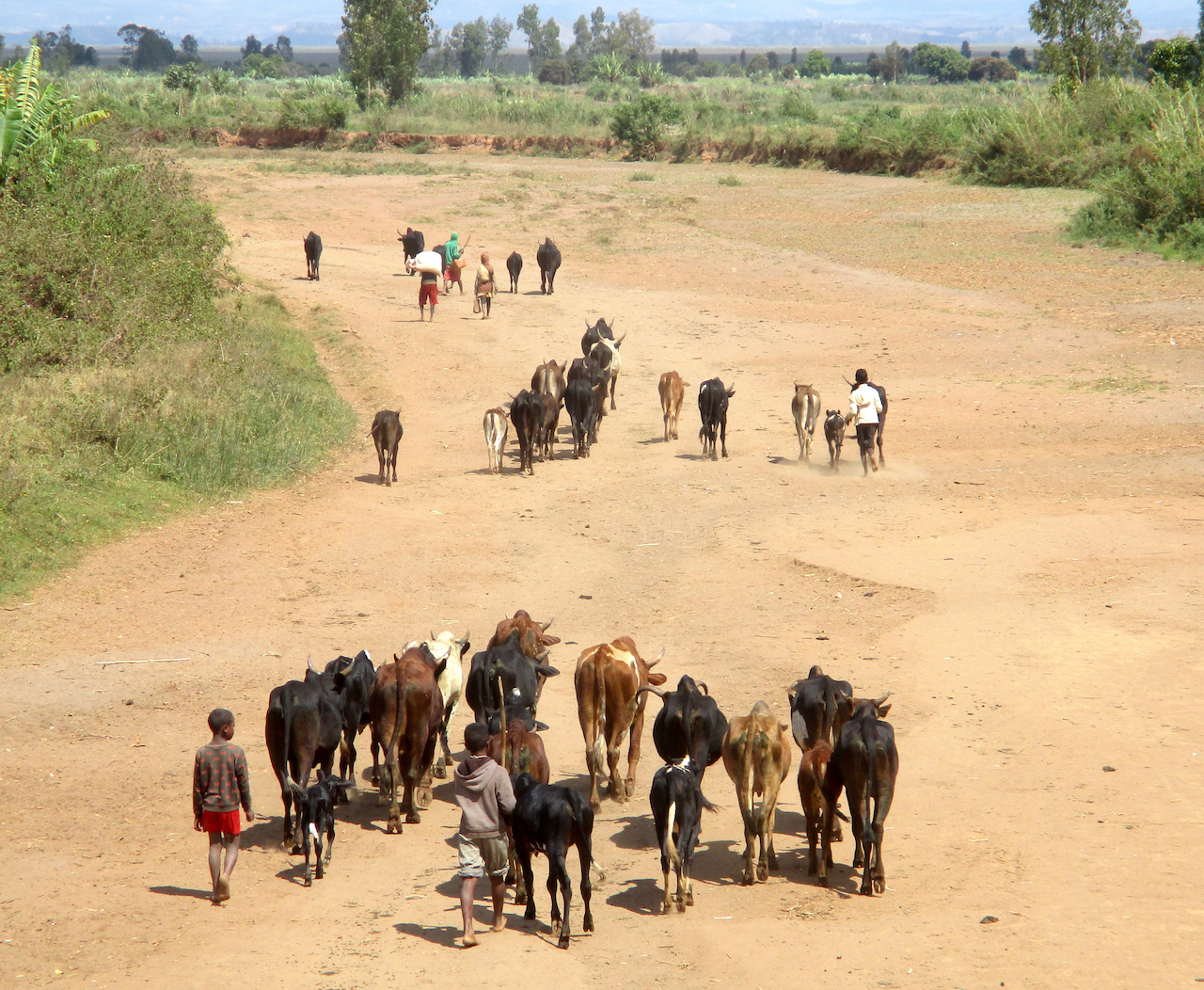
Contrasting conservation
In 2015, as part of the government’s designation of the Alaotra protected area, DWCT started a conservation program in collaboration with Alaotra Rano Soa. The regional body, established as part of the lake’s Ramsar designation, helps oversee activities relating to the lake, such as rice growing, fishing, aquaculture, goose and cattle husbandry, water management, tourism, crafts, and transportation, at the community level. Alaotra Rano Soa manages the sprawling Ramsar site while DWCT manages the smaller protected area within it.
DWCT and Alaotra Rano Soa established four activity sectors to provide a forum for local people to manage the Ramsar site: 45 commune-level federations that collectively involve 333 village-level community associations, each one active in either watershed protection, water-resource management, fisheries management or marsh conservation. The program employs 96 polisin-jetra, or marsh police agents, as its ambassadors in the protected area. They report any environmental violations to DWCT, but can’t make arrests.
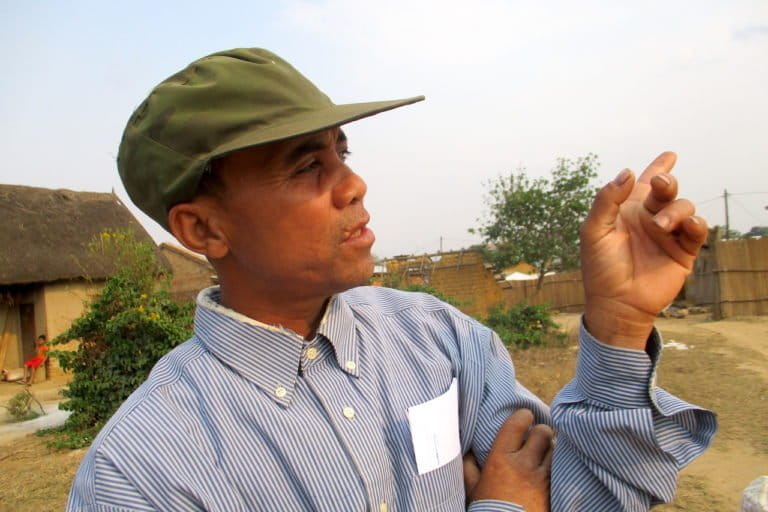
In 2017, DWCT, Alaotra Rano Soa and government authorities publicly marked the limits of the protected area. Parcels totaling nearly 7,000 hectares (17,300 acres) of marshland were set aside for the use of local communities, who rely on the lake’s resources for foods and income. However, with some exceptions, this area has largely succumbed to commercial rice planting, forcing subsistence farmers into protected marshland to meet their needs.
“The biggest issue we were facing was the fact that local businesses managed to control 90% of the set-aside 7,000 hectares, instead of the community members,” said Ralainasolo, the DWCT conservation biologist.
Two of the lake’s rural communes offer a study in contrasts when it comes to managing their slices of set-aside marsh. Imerimandroso’s marsh cover is on the verge of disappearance, whereas its neighbor on the northeastern lake shore, Andrebakely Avaratra, has retained most of its marsh. Like the dozens of communes around the wetland, Imerimandroso and Andrebakely Avaratra, with respective populations of around 16,000 and 19,900, rely on rice growing, farming, fishing and crafting for their food and income. For centuries, the lake has provided people’s daily needs.
Of the 400 or so hectares (about 1,000 acres) the marsh community association in Imerimandroso is responsible for, scarcely a dozen persist, and the local businesses and subsistence farmers who grow vary jeby are clamoring for access even to these.
“Little by little, they invaded the protected area as of 2008,” Dauphin Andriakotoarivony, deputy mayor of Imerimandroso and a deputy president of Alaotra Rano Soa, said. “Hardly 7 hectares [17 acres] of the initial 209 [516 acres] we have secured where I am [in Marovato sector] has been left. Practically 99% of the protected area is ruined. Also, the rest is already prone to invasion. The encouraging thing is that the community association has never abandoned the fight.”
Randriamatsarasoa, the fisher from Imerimandroso, is very concerned with the eventual exhaustion of the fish stocks. According to him, the introduced tilapia (several species in the family Cichlidae) and carp (Cyprinus carpio) that were once abundant in Lake Alaotra and are the main source of income for local fishers have declined precipitously, having long since displaced native fish species. He attributes the disappearance of the fish to people using insecticide-laced mosquito nets with small meshes that scoop up juveniles, and clearing marshes where fish and other aquatic animals reproduce.
“When the water is well managed, I can tell you that fishing is more profitable than rice growing,” he said. A kilo of freshwater fish now costs seven or eight times more than a kilo of rice.
The failure of the marsh conservation project in Imerimandroso was attributable to political leadership, according to Ralainasolo of DWCT. He said the commune’s previous mayor was under a great deal of pressure from local powerbrokers to permit illegal marsh clearing.
The current mayor, Randriangalisa, elected in December 2019, professed his commitment to turning things around. “We will be standing up as long as we can to conserve the little left. We will keep silent only when our voice is heard,” Randriangalisa said.
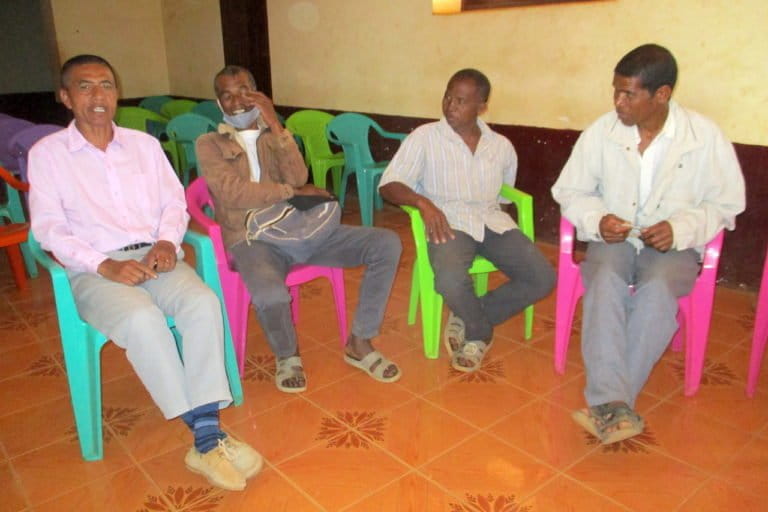
By contrast, the people of Andrebakely Avaratra have been “stricter” than their neighbors about protecting the marshes, José Ramaninjatovo, the commune’s mayor, told Mongabay. “As meadow, they are the zebus’ larder,” he said, referring to Malagasy cattle. “They supply us with fishes. They protect the rice fields from alluvial deposits from the hills.”
The previous mayor of Andrebakely Avaratra showed strong leadership and the population appreciated the importance of the marshes, according to Ralainasolo.
The current mayor, Ramaninjatovo, said he intends to carry on that commitment. He said 19 people were caught destroying the marshes in mid-February, and the environment ministry’s local offices made them replant the areas with reeds and sign a letter promising never to harm the marsh. “We will never allow such a violation to happen again,” he said.
Thanks to Andrebakely Avaratra’s enduring marsh, the commune has become one of the main suppliers of dried reed to Imerimandroso, where women use it to weave baskets, hats, bags and other crafts for income.
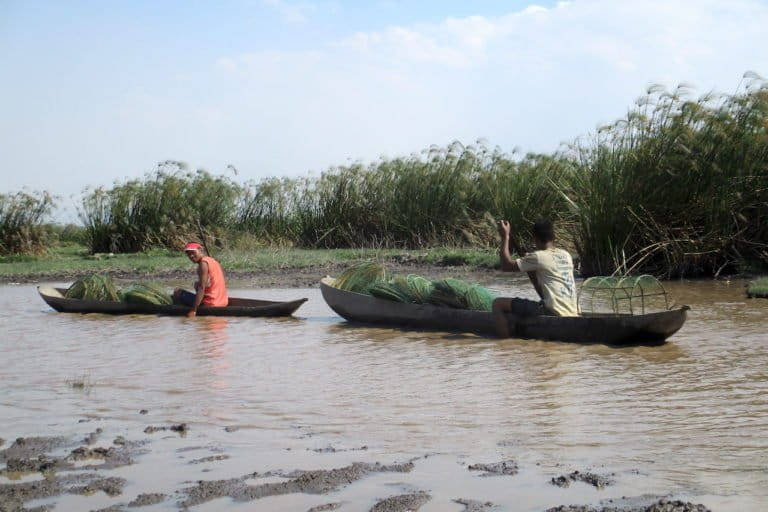
Everyone seems to comply with the rules in Andrebakely Avaratra. Two fishermen sailing back from the open lake on an afternoon in late October each had a pile of locally made basketry fish traps called vovos. “We have removed them from the water to the village as the water is now closed,” one of them told Mongabay, referring to the lake’s annual fishing closure. It had started the day before and would last eight weeks to allow the fish to reproduce. “We take our fishing tools into water again when the water reopens.”
That kind of compliance with protective rules is typical in Andrebakely Avaratra, regardless of whether people belong to the community association or not, according to a marsh police agent named Gabriel Ralijaona in the commune’s main village. “We are very strict with the protection of the 658 hectares [1,626 acres] of marshes inside our common land,” he said. “An array of endemic birds, countless animal species including four specimens of bandro — three adults and one baby — live there. We never let anyone disturb these places.”
The bandro is the emblematic species of Lake Alaotra. With a population of less than 3,000, down from the first estimate of between 7,000 and 11,000 in 1990, the lemurs are among the world’s most endangered primates. The adults in Andrebakely Avaratra were former pets reintroduced into the wild in 2015. Andrebakely Avaratra’s marsh was chosen to host them because it was in good shape after the community had nursed it back from being “totally broken down” in the 1990s, according to Ralainasolo of DWCT. Of the five animals released in the area, two disappeared and were thought to have been hunted. But one female appeared with a newborn soon after.

Businesses behind the destruction
Around the lake, however, Ralainasolo pointed out that the bandro’s unmistakable population decline closely tracks the loss of marsh habitat. And most of the time, he said, businesses are behind the clearing. His team estimates it costs an average of 1 million ariary ($254) to clear one hectare of marsh. If so, the average destruction of around 850 hectares annually would theoretically require around 850 million ariary, or $216,000.
That kind of money, even to clear a single hectare, is out of reach for most residents. Instead, powerbrokers and banks finance the marsh’s destruction, paying poor locals to do the clearing, according to local public servants who requested anonymity out of fear of retaliation. Mayor Randriangalisa of Imerimandroso said he had experienced pressure tactics. “After a TV station broadcast my criticism of the marsh destruction, high-placed people and one bank officer called me and asked me to stop questioning their business,” he said.


It’s a similar story when it comes to fishing. According to an anonymous source at the regional fishing department, local businesses fund the fabrication of nets up to a kilometer long that cost 6 million to 8 million ariary (up to $2,033). Businesses deploy around 30 of these killing machines in Lake Alaotra, plus another 50 smaller ones. “They are illegal and their use not only endangers stock availability in the future but also harms aquatic species,” the source said.
Over the years, marsh restoration projects on the banks of the lake, like the one the environment minister attended in February, have been successful. Experts say that if the reeds are left to regrow in peace they can recover in a few years’ time. But against the backdrop of pervasive lawlessness, the outlook for Lake Alaotra’s marshes remains uncertain.
Like many other people weary of the impunity, Randriangalisa calls for exemplary sanctions for the marshes’ destroyers. Meanwhile, the environment ministry is implementing a zero-tolerance policy against any illegal environmental destruction across the country.
According to sources interviewed for this story, eight powerbrokers residing in the area’s main city of Ambatondrazaka are suspected of funding illegal activities imperiling the wetland, including marsh clearance and fishing with large mosquito bed nets. They were summoned to appear in court in December, but the court date was postponed and a new one has yet to be made public. The outcome of the case could be a bellwether for Lake Alaotra’s future.
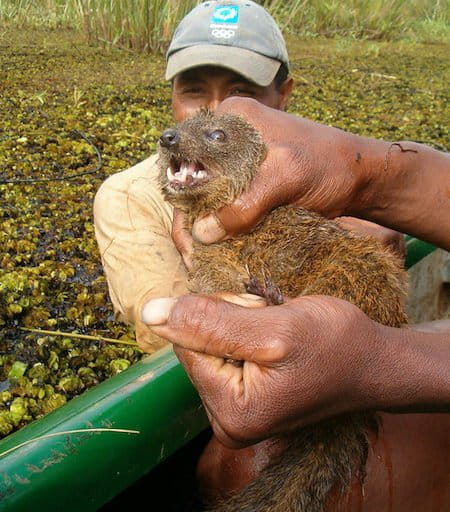
Banner image: Bandro, or Alaotra gentle lemurs (Hapalemur alaotrensis), that were released in Andrebakely Avaratra commune’s marsh in 2015. Image courtesy of Durrell Wildlife Conservation Trust.
Clarification 4/8/21: The story has been updated to clarify that the forum that DWCT and Alaotra Rano Soa established, comprising commune-level federations and village-level community associations, manages the Lake Alaotra Ramsar Site, and not just the lake itself.
FEEDBACK: Use this form to send a message to the editor of this post. If you want to post a public comment, you can do that at the bottom of the page.
